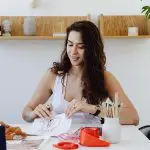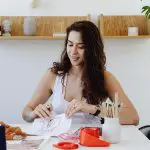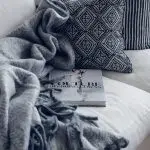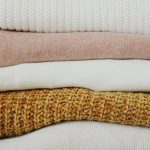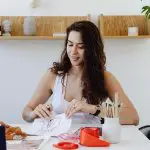Are you frustrated with blotchy fabric dye? Nothing can be more annoying than spending time and effort on a dyeing project, only to find out that the color is uneven and splotchy.
Luckily, there are ways to fix the problem and salvage your project. In this article, you will learn the common causes of blotchy fabric dye and how to determine the severity of the issue.
You will also discover different methods to correct the problem, including using a color remover, dye fixative, or fabric marker, and practicing proper fabric dyeing techniques for future projects.
With these tips and tricks, you can easily fix blotchy fabric dye and create beautiful, even colors on your fabrics.
Table of Contents
Understand the Common Causes of Blotchy Fabric Dye
You may be feeling frustrated if your fabric dye came out blotchy, but understanding the common causes can help you prevent it from happening again.
One of the most common causes of blotchy fabric dye is uneven dye distribution. This can happen when the fabric is not properly prepared before dyeing, or when the dye is not applied evenly. To prevent this, make sure to prewash your fabric to remove any sizing or dirt that may interfere with the dyeing process. Also, make sure to stir your dye solution regularly and apply it evenly to the fabric.
Another cause of blotchy fabric dye is inadequate rinsing. If you don’t rinse your fabric thoroughly enough after dyeing, residual dye can remain in the fabric, causing uneven color. To prevent this, rinse your fabric thoroughly with clean water until the water runs clear. You can also add a small amount of vinegar to the rinse water to help remove any remaining dye.
Lastly, using the wrong type of fabric for dyeing can also cause blotchy color. Some fabrics, such as polyester and acrylic, are difficult to dye evenly and may require special dyes or techniques. If you’re not sure if your fabric is suitable for dyeing, do a small test first to see how it takes the dye.
By understanding the common causes of blotchy fabric dye, you can take steps to prevent it from happening and achieve the vibrant, even color you desire.
Determine the Severity of the Blotchiness
Depending on the extent of the issue, it may be necessary to take more drastic measures. Before deciding on a solution, you should determine the severity of the blotchiness. This will help you choose the appropriate method to fix the problem.
To determine the severity of the blotchiness, you can use the following table as a guide:
| Severity | Description |
|---|---|
| Mild | Blotchiness is only noticeable upon close inspection |
| Moderate | Blotchiness is noticeable from a few feet away |
| Severe | Blotchiness is very noticeable and covers a large area |
If the blotchiness is mild, you may be able to fix it by applying more dye to the affected areas. However, if the blotchiness is moderate or severe, you may need to try a more drastic solution.
For moderate blotchiness, you can try to remove the existing dye by soaking the fabric in a solution of hot water and detergent. After the fabric has soaked for a few hours, rinse it thoroughly and then re-dye the fabric. For severe blotchiness, you may need to bleach the fabric before re-dyeing it. Keep in mind that using bleach can weaken the fabric, so be sure to follow the instructions carefully and rinse the fabric thoroughly after bleaching.
Try a Color Remover
One option to consider for improving the appearance of your colored material is trying a color remover. These products are specifically designed to remove dye from fabric without damaging the material.
Here are some things to keep in mind when using a color remover:
- Choose a color remover that’s appropriate for the type of fabric you’re working with. Some products are designed to work best on natural fibers, while others are better suited for synthetic materials.
- Follow the instructions carefully to ensure that you use the product correctly. This may involve soaking the fabric in the color remover for a certain amount of time, or applying the product directly to the affected areas.
After using a color remover, it’s important to thoroughly rinse the fabric to remove any remaining residue. This will help to prevent any new dye from adhering unevenly to the material.
Keep in mind that a color remover may not completely eliminate all blotchiness from your fabric, especially if the dye has already set. However, it can be a useful tool for improving the overall appearance of your material and preparing it for further dyeing or other treatments.
If you’re unsure about how to use a color remover or which product to choose, consider consulting with a professional fabric dyeing service for guidance.
Use a Dye Fixative
To improve the color retention of your newly dyed material, it’s important to use a fixative that can help to set the dye and prevent it from fading or bleeding. A dye fixative is a chemical solution that is added to the fabric during the dyeing process. It works by bonding with the dye molecules, making them more resistant to water and fading.
There are different types of dye fixatives available, but the most commonly used are sodium carbonate and vinegar. Sodium carbonate is a strong alkaline solution that helps to set the dye and make it more permanent. Vinegar, on the other hand, is an acidic solution that can be used to fix both natural and synthetic dyes. It works by lowering the pH of the fabric, which helps to set the dye and prevent it from bleeding.
To use a dye fixative, simply add it to the dye bath according to the manufacturer’s instructions. Make sure to mix the fixative well with the dye before adding the fabric. After dyeing, rinse the fabric thoroughly to remove any excess dye and fixative. You can also add a small amount of fixative to the rinse water to give your fabric extra protection against fading and bleeding.
Using a dye fixative is an easy and effective way to improve the color retention of your fabric dye. By bonding with the dye molecules, it can help to set the color and prevent it from fading or bleeding. So next time you’re dyeing fabric, don’t forget to add a fixative to keep your colors looking bright and beautiful for longer.
Dip Dye or Tie-Dye the Fabric
If you’re feeling creative, why not try dipping or tie-dyeing your newly dyed material to add some unique and eye-catching patterns? This method is perfect for fixing blotchy dye jobs, as it allows you to cover up any uneven spots with colorful designs.
To get started, gather your materials: fabric dye, water, rubber bands, and a large container for dipping. Mix up your dye according to the package instructions and fill your container with enough water to submerge your fabric. Then, use rubber bands to create patterns on your fabric, such as stripes or swirls.
Once your fabric is ready, it’s time to start dipping! Submerge your fabric in the dye mixture, making sure to hold it under for a few minutes to ensure the color fully saturates the material. You can also experiment with partial dips to create a gradient effect.
After the desired amount of time, rinse your fabric in cold water to remove any excess dye and hang it up to dry. And voila! Your once-blotchy fabric now has a unique and beautiful design.
Use a Fabric Marker or Paint
Get creative and add a personal touch to your material by using fabric markers or paint to draw intricate designs or bold patterns, bringing your garment to life with vibrant colors and unique details. This method is perfect for fixing blotchy fabric dye because it allows you to cover up any uneven spots with a fun and eye-catching design. Plus, it’s a great way to salvage a garment that might otherwise be unwearable.
When choosing a fabric marker or paint, make sure to select a product that is specifically designed for use on fabric. This will ensure that the color adheres properly and doesn’t wash out or fade over time. You can find a wide variety of fabric markers and paints at your local craft store or online. Experiment with different colors and techniques to create a truly one-of-a-kind piece.
To get started, sketch out your design on a piece of paper or directly onto the fabric using a pencil. Once you have your design in place, use a fabric marker or paint to carefully fill in the details. Don’t be afraid to make mistakes or try new things – that’s part of the fun! When you’re finished, let the fabric dry completely before wearing or washing. With a little bit of creativity and patience, you can turn a blotchy fabric dye disaster into a work of art.
| Pros | Cons |
|---|---|
| Allows you to add a personal touch to your garment | Can be time-consuming |
| Covers up blotchy fabric dye spots | Requires artistic skill |
| Creates a unique, one-of-a-kind garment | May not be suitable for all types of fabric |
| A fun and creative DIY project | Can be messy |
| Affordable and accessible | Requires special fabric-specific markers or paint |
Practice Proper Fabric Dyeing Techniques for Future Projects
Mastering proper fabric dyeing techniques is key to achieving beautiful and vibrant results in all your future DIY projects. One important technique is to always prewash your fabric before dyeing it. This removes any residual chemicals or dirt that may prevent the dye from penetrating evenly. It also helps to ensure that the fabric shrinks before dyeing, preventing any unevenness in the final product.
Another important technique is to use the right amount of dye. Adding too little dye can result in a faded look, while adding too much can cause blotches and unevenness. Follow the instructions on the dye package carefully, and measure out the dye and water accurately. It’s also a good idea to use a dye fixative to help set the color and prevent fading.
Make sure to stir the fabric in the dye bath frequently to ensure even color distribution. You can also try using different dyeing techniques, such as tie-dye or ombre, to create interesting and unique patterns.
With practice, you’ll be able to master these techniques and achieve beautiful results in all your future fabric dyeing projects.
- Tetron Fabric for Marine Applications: Durability and Use Cases - June 18, 2025
- Tetron Fabric for Outdoor Furniture: Weather Resistance and Care - June 18, 2025
- Tetron Fabric for Wall Coverings: Style and Application Tips - June 18, 2025

